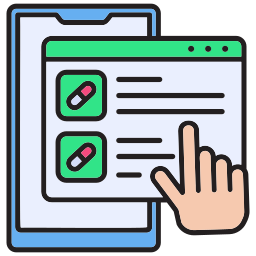Cerner integration is a prominent figure in the healthcare industry, offering advanced EHR systems that streamline patient data management. Cerner integration is crucial to the global healthcare sector, with over 27,000 healthcare facilities worldwide using its solutions.
With Cerner integration technology, healthcare providers can efficiently organize, store, and access critical information across various medical settings. The ability to exchange data seamlessly is important in healthcare today. It ensures that patient information is accurate and up-to-date, facilitating informed clinical decisions and improving patient outcomes. Efficient data exchange is a technological advantage and a cornerstone of effective healthcare delivery, enabling better coordination and continuity of care.
Let’s learn more about Cerner integration and how it helps healthcare providers:
What is Cerner Integration?
Cerner integration refers to connecting the Cerner EHR system with other healthcare software and systems to facilitate efficient data exchange and interoperability. This integration allows healthcare providers to consolidate patient information from various sources, providing a unified view of patient health data.
Cerner integration utilizes standard protocols that ensure that different systems communicate effectively, improving clinical workflows, data accuracy, and patient care coordination. This approach supports informed decision-making and optimizes healthcare operations, making it easier for medical professionals to access and manage patient information.
How Does Cerner Integration Help Healthcare Providers?
Cerner integration improves healthcare delivery by connecting the EHR system with other healthcare applications and systems. The integration enables the efficient flow of patient data across various platforms, ensuring healthcare providers have access to accurate and up-to-date information. By consolidating patient records from different sources, Cerner integration helps create a unified patient history, which aids in better clinical decision-making and enhances patient care coordination.
With Cerner integration, healthcare providers can streamline workflows, reducing the time and effort required to input and retrieve patient data. Together with time savings, this effectiveness reduces mistakes, which enhances patient safety.
Additionally, Cerner integration supports interoperability, allowing different healthcare systems to communicate and share data effectively. This interconnection is critical for providing complete patient care, optimizing resource allocation, and increasing overall operational efficiency in healthcare institutions.
Now that we understand how Cerner integration helps healthcare providers, let's learn more about the pros and cons of Cerner integration.
Pros of Cerner Integration
✅ Improved Patient Care
Cerner integration allows healthcare providers to access the complete medical history of patients, leading to better-informed clinical decisions. This comprehensive view of patient information ensures accurate diagnoses and personalized treatment plans, ultimately improving patient outcomes.
✅ Increased Efficiency
Modernizing workflows through Cerner integration reduces the need for manual data entry. Automated processes streamline administrative tasks, allowing healthcare professionals to focus more on patient care and less on paperwork. This efficiency boosts productivity and reduces the risk of human error.
✅ Enhanced Billing Processes
Cerner integration optimizes billing procedures by reducing errors and speeding up claim submission. Accurate and timely billing ensures healthcare providers receive payments faster, improving the organization’s financial health. Streamlined billing processes also reduce administrative burdens and enhance overall operational efficiency.

✅ Better Population Health Management
Cerner integration supports better population health management by providing a unified platform for analyzing and tracking health trends across different patient groups. This capability helps healthcare providers identify at-risk populations, monitor health outcomes, and implement preventive measures, contributing to improved public health initiatives.
✅ Better Design
Cerner's EHR system is well known for having an intuitive user interface that makes it simpler for medical professionals to browse and handle patient data. The user-friendly design decreases the learning curve for new users while increasing productivity by simplifying complicated operations.
✅ Comprehensive Support
Cerner offers substantial help to its users via email, phone, and live chat, ensuring that any concerns are resolved quickly. This degree of support is critical in healthcare settings where immediate help may make a difference in patient care.
✅ Remote Usability
The ability to use Cerner EHR remotely is a significant advantage since it enables healthcare practitioners to access patient information and perform their commitments from anywhere. This adaptability is especially useful in today's healthcare industry, where telemedicine is becoming more common.
✅ Security Features
Cerner has strong security measures to protect patient data, meeting the essential requirements for privacy and adherence to laws like HIPAA. These features guarantee that sensitive information is protected from unwanted access.
These are a few of the pros of Cerner integration in healthcare businesses.
Cons of Cerner Integration
❌ Complexity of the Integration Process
One significant challenge of Cerner integration is the complexity involved in the process. Implementing Cerner’s system often requires a high level of technical expertise. Healthcare organizations must ensure they have the right personnel or third-party support to handle the intricacies of integrating various systems and workflows smoothly.
❌ Potential for Data Security Risks
While integrating Cerner, the potential for data security risks arises. Ensuring secure connections and safeguarding sensitive patient information is crucial. Any vulnerabilities in the integration process can expose healthcare data to unauthorized access, making robust security measures and constant monitoring essential to protecting patient privacy.
❌ Cost of Implementation and Ongoing Maintenance
The cost associated with Cerner integration can be substantial. Initial implementation expenses, including software, hardware, and training, can strain budgets. Additionally, ongoing maintenance and updates require continuous investment. Healthcare providers must weigh these costs against the long-term benefits of an integrated system, considering both financial and operational impacts.

❌ Training and Adaptation Period
Another drawback of Cerner integration is the training and adaptation period required for staff. Transitioning to a new system can be challenging for healthcare providers, who must learn new workflows and interfaces. This learning curve can temporarily impact productivity and may require ongoing training and support to ensure all users are proficient and comfortable with the new system.
❌Limited Functionality in the Basic Package
Startups often face significant challenges when integrating new systems into their operations. This is particularly true in healthcare, where the complexity of data and the need for seamless interoperability are paramount. Despite being reasonably priced, the basic package only offers a limited number of functions. Startups must carefully evaluate their needs and the capabilities of the basic package to avoid unexpected costs and ensure smooth integration into their workflows.
❌ Intermittent Software Updates
While required for security and functioning, they can cause productivity disruptions. Users must often adjust to changes or endure brief outages during these upgrades.
Why Choose HealthConnect CoPilot for Cerner Integration?
HealthConnect CoPilot offers a practical solution for addressing the challenges of Cerner integration. Designed to simplify the integration process, We ensure that healthcare providers can efficiently manage patient data across various systems. With an emphasis on ease of use, HealthConnect CoPilot minimizes the technical complexity typically associated with Cerner integration.
Security is an important feature of HealthConnect CoPilot, providing healthcare organizations with confidence that patient data remains protected throughout the integration process. Additionally, HealthConnect CoPilot is built to scale, accommodating the needs of small clinics as well as large hospital networks, making it a versatile choice for any healthcare provider.
Choosing HealthConnect CoPilot brings added advantages. Our extensive experience in healthcare technology ensures that the integration process is handled with expertise. Their dedicated support team is available to assist at every step, ensuring a smooth and efficient transition to Cerner integration. This combination of innovative technology and reliable support makes HealthConnect CoPilot the ideal choice for healthcare providers looking to optimize their systems.
HealthConnect CoPilot offers a reliable solution for Cerner integration challenges, focusing on simplicity, security, and scalability. With us, healthcare organizations can navigate the complexities of integration with confidence, knowing that their data is secure and their systems are optimized for efficiency.
- What are the key benefits of integrating with Cerner?
Integrating with Cerner offers improved interoperability, streamlined clinical workflows, and better access to patient data across systems. It enhances overall efficiency and supports more informed decision-making in healthcare settings.
- What challenges should I expect during Cerner integration?
Challenges may include the complexity of data migration, the need for extensive staff training, and potential disruptions to existing workflows. It's crucial to plan and allocate resources effectively to manage these challenges.
- How does Cerner integration impact patient care?
Cerner integration can positively impact patient care by providing healthcare providers with comprehensive patient records, enabling more accurate diagnoses, and facilitating timely treatment decisions. However, initial implementation may temporarily affect workflow efficiency.
- What factors should I consider before choosing Cerner integration?
Consider your organization's existing IT infrastructure, budget, and long-term goals. Assess the compatibility of Cerner with your current systems and the level of support available for integration and ongoing maintenance.

Pravin Uttarwar, CTO of Mindbowser
As the CTO of Mindbowser, a healthcare-focused software development company, I am dedicated to delivering cutting-edge digital solutions that transform patient care and operational efficiency. With over 16 years of experience and as an MIT alumnus, I specialize in healthcare interoperability, FHIR-compliant systems, and AI-powered platforms, crafting scalable products and architectures tailored to the unique needs of healthcare providers and enterprises.
I have spearheaded the development of over 100 products and platforms, guiding them from concept to full-fledged solutions. My expertise extends to scaling remote tech teams, driving EHR integrations, and building secure, cloud-native healthcare solutions. By shaping technology visions and roadmaps, I help clients achieve long-term growth and success in the rapidly evolving healthcare landscape.
HealthConnect CoPilot enabled us to access real-time patient health data through integration with Apple HealthKit, enhancing care delivery while maintaining HIPAA compliance. This led to personalized care and improved outcomes for patients.

AI-enhanced Obstetrics Clinical Decision Support Platform
HealthConnect CoPilot's integration with Epic's Hyperspace has transformed our workflow. Automated post-delivery examinations and HL7 protocol use ensure accurate updates to Epic. Their expertise empowers informed decision-making in childbirth

Top Provider for Customized Healthcare Solutions
HealthConnect CoPilot's helped us to integrate with leading tracking devices such as Apple Watches and Fitbit. This integration enables effortless syncing of health data, providing users with real-time insights displayed directly on our flagship products: smart mirrors and digital calendars.

A Provider of Customizable Display Solutions
Post a comment Cancel reply
Related Posts
Ambulatory EHR vs Inpatient EHR: Which One is Right for Your Practice?
EHRs help doctors and healthcare staff store, access, and manage patient information digitally. They improve…
Ambulatory EHR: A Complete Guide for Healthcare Providers
Healthcare providers are moving beyond paper records and legacy systems, and ambulatory EHRs are leading…
Epic Integration with SMART on FHIR: A Complete Guide
The challenge of integrating AI-driven tools and third-party applications with Epic’s EHR system has long…
Epic EHR Integration – Unlocking Seamless Healthcare Connectivity
The EHR integration has revolutionized healthcare by enabling secure, real-time access to patient data. Epic…
Epic FHIR Integration: Making Interoperability Seamless for Healthcare Providers
Healthcare systems generate massive amounts of patient data daily, but without Epic FHIR integration, this…
Epic EHR Explained: How It Transforms Healthcare Operations and Patient Care
Epic EHR has become a cornerstone of modern healthcare, providing hospitals and clinics with a…










